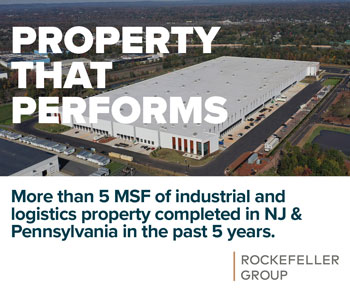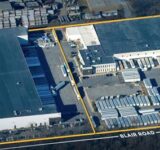Demand for parking in and around industrial properties has soared in New Jersey, fueled largely by the use of large delivery fleets, spurring changes in building design and creating new revenue streams for industrial owners.
By Joshua Burd
Demand continues to surge in top industrial real estate markets, with little sign of slowing down, but it’s not just for space inside the four walls.
According to brokers and landlords, parking requirements have soared alongside tenants’ search for warehouse and distribution facilities. The growing demand — which is often tied to the use of large delivery fleets in northern New Jersey and other population centers — is now spurring changes in building design and creating new revenue streams for industrial owners, while adding to an already insatiable appetite from investors.

“You’re seeing that more in the true last-mile, infill locations, because it’s all about turns and getting the products (to customers),” said Jeff Milanaik, Bridge Industrial’s Northeast region partner, noting that parking needs are especially intense at e-commerce delivery centers, which typically feature smaller warehouses served by large numbers of vans and box trucks. “That’s where you’re going to see continued demand for fleet parking.”
The trend has emerged over the last two to three years, experts say, fueled first by Amazon and now increasingly by logistics, delivery and traditional retail companies.
“With parking, it’s no longer ‘By the way, we need it,’ ” said David Knee, a vice chairman and broker lead for JLL’s three-state Northeast industrial region, which is based in East Rutherford. “It’s at the forefront of the requirement.”
With land increasingly hard to come by in North Jersey, parking rents in locations such as Newark are some 50 percent higher than they were in 2019, according to JLL research. The firm also pointed to leasing volume for parking space in the region since the start of 2020, which equates to double the acreage leased from 2018 through 2019.
Industrial owners are capitalizing on that demand by charging for anything deemed to be above standard parking at their buildings — typically, one car space per 1,200 to 1,500 square feet of warehouse area and one trailer spot per dock door.
“Historically, that was always a New York City thing,” Milanaik said. “You can actually charge rent if you have a user that has that demand.”
The requirements are also now factoring into building design, Knee said, as developers consider structures that leave more room for surface parking.

“Owners are becoming more diligent not to overbuild sites,” he said. “They’re accommodating now for these tremendous parking requirements and they’re not your historic 53-foot trailer parking, per se. They’re all different sizes of vehicles — it could be sprinter vans, it could be box trucks and it could be everything in between. And it could be car parking as well.”
In some cases, developers are providing a solution by going vertical. At its Sunset Industrial Park in Brooklyn, Bridge is developing a roughly 90,000-square-foot building for FedEx that will feature rooftop parking, Milanaik said. It’s now exploring a similar concept at infill sites in northern New Jersey, which would comprise a conventional warehouse on the ground floor with the ability to park a fleet of vans or box trucks on the upper level.
Tenants with delivery fleets have also turned to leasing parking lots, regardless of whether there is a functional warehouse on the parcel. That has provided another opportunity for the likes of Prologis, which has acquired more than a dozen properties over the past two years in New Jersey, New York and the Philadelphia area that are either completely vacant or have small buildings relative to their overall surface areas.
Those include assets such as 520 Belleville Turnpike in Kearny, which totals eight acres with just a 12,500-square-foot on the property. The balance of the site provides the potential for 138 trailer spaces or 478 van spaces, along with 84 spots for cars.
“There really is value in parking these days and it’s hard to get, so we’ve really been focused on those types of acquisitions recently in Philadelphia, New Jersey and New York,” said Jesse Harty, a Prologis senior vice president and market officer for New Jersey and New York. He noted that, as recently as two years ago, parking lots or low-coverage sites would have been prime candidates for redevelopment by industrial builders, but the demand for fleet parking and the lack of supply have made it increasingly profitable to keep them as is.

“Parking lot rents have catapulted in last 18 months,” Harty said, adding that they’ve increased by some 60 percent in New Jersey to around $25,000 per month per acre. Rates in the outer boroughs are still nearly triple that amount and up to 10 times as much in Manhattan, he added, so “there is still value and rent growth in New Jersey.”
Milanaik has also seen parking requirements grow at more sprawling sites such as Bridge Point 78, a new industrial park in Phillipsburg and Lopatcong that is slated to include up to 4 million square feet. The firm is now constructing a fifth building on the site, where plans also call for a sixth, but a user recently inquired about using the final parcel for trailer and regional truck parking instead, he said.
Bridge Industrial had long considered that as a possibility as it has been building out the site along Route 22, Milanaik said.
Knee expects that to become more common at large, master-planned industrial campuses. With the ability to monetize the additional parking and the potential savings from not erecting another building, it becomes a worthwhile consideration for developers.
“In some instances they’re actually doing better because they don’t have the vertical risk of actually building something,” he said, although landlords also must consider the downside. For instance, a fully developed building may provide a greater opportunity for rent growth in subsequent years than a parking lot would.
Still, the possibility creates another reason for developers to build the sites in phases, which they are typically doing anyway based on the available infrastructure or with the aim of managing their risk.
“We see it on some of our projects, where the owners are willing to pivot and not build the building, but they’re going to get compensated for it,” Knee said.
Much like the still-surging rental rates in the industrial sector, parking revenue will loom large in helping developers underwrite the ever-growing cost of land, Knee said. He added that, as demand has soared, institutional investors have grown wise to the value of parking in markets such as North Jersey — and the potential revenue stream that comes with it.
“Even in the underwriting today, sellers are getting paid for parking on the sale,” Knee said. “And then the new owners and new investors are certainly underwriting that to make sure they capture that revenue because … deals are very thin, cap rates are down (and) there’s a tremendous amount of money chasing very few deals, so people have to make sure that they don’t miss any revenue opportunities.”

Institutional investors have also turned their focus to pure parking sites in dense, infill markets such as Port Newark-Elizabeth, said Alex Kachris, a research manager with JLL. That’s due in large part to the flight of large, multinational tenants to the properties, a far cry from the locally based trucking firms and other noncredit tenants that rented the lots in past decades.
“Fast-forward to today, when all of these e-commerce and big retailers are in the market looking to park their fleets, it’s really revolutionized the entire sector,” Kachris said. “So with that, the big capital is pushing right behind it … and it’s also caused an increase in value for these sites, not only because the rents are higher but because the cap rates have compressed.”
A new twist on traffic concerns
The growing number of delivery centers in northern New Jersey may be smaller than the sprawling, big-box warehouses that have become common in recent years, but that doesn’t mean they are always welcomed by local residents.
Bridge Industrial’s Jeff Milanaik points to the large fleets of vans and midsized delivery trucks that are typically shuttling to and from the sites.
“It’s always been traffic every time we’ve done anything going back decades,” said Milanaik, Bridge’s Northeast region partner, referring to the concerns of municipal leaders. “The bigger buildings certainly attract more attention for truck traffic and the impact on the surrounding region, but also when you do the smaller delivery-type buildings, it’s the same conversation but a different focus, because they tend to be more urban, smaller areas that are more congested, and you could be dealing with a (fleet of) couple hundred.”

Still, many delivery centers have a key differentiator. Dan Disario, a Lawrenceville-based principal and traffic consultant with Langan, said the facilities typically don’t begin operations until 9 a.m., in an effort to avoid the morning rush hour.
“I would characterize a delivery station as a very compatible land use no matter its location, because in those typical commute times when volumes on the streets are their highest, the delivery stations are relatively low-activity,” Disario said. “So having their highest activity occur late morning by and large fits very well if not for all sites, almost all sites, for that reason.”









